Tower Of London
 From Nwe
From Nwe | Tower of London* | |
|---|---|
| UNESCO World Heritage Site | |
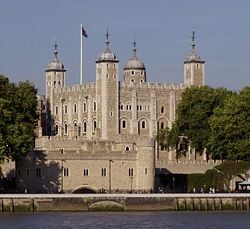 |
|
| State Party | |
| Type | Cultural |
| Criteria | ii, iv |
| Reference | 488 |
| Region** | Europe and North America |
| Inscription history | |
| Inscription | 1988 (12th Session) |
| * Name as inscribed on World Heritage List. ** Region as classified by UNESCO. |
|
The Tower of London (known historically simply as The Tower), is an ancient fortress and historic monument in central London, England on the north bank of the River Thames. It is located within the London Borough of Tower Hamlets and is separated from the eastern edge of the City of London by the open space known as Tower Hill.
The Tower of London is sometimes identified with the White Tower, the original stark square fortress that was built by William the Conqueror in 1078 and finished by his sons and successors, William Rufus and Henry I, around 1087. However, the official site—the formal name of which is Her Majesty's Royal Palace and Fortress The Tower of London—is a complex of several buildings set within two parallel rings of defensive walls and a moat.
The Tower's primary function was a fortress, a royal palace, and a prison, particularly for noble and royal prisoners. It has also served as a place of execution and torture, an armory, a treasury, a zoo, a mint, a public records office, an observatory, and the home of the Crown Jewels. It is a UNESCO World Heritage Site and one of London's most popular tourist attractions.
History
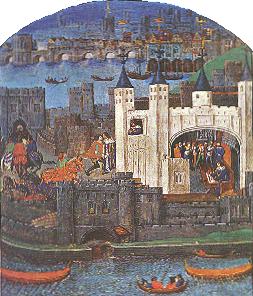
The Tower of London was founded in 1078, when William the Conqueror ordered the White Tower (also known as the Great Tower) to be built inside the southeast angle of the city walls, adjacent to the Thames.
It functioned as much to protect the Normans from the people of London as to protect London from outside invaders. William ordered the Tower to be built of Caen stone, which he had specially imported from France, and appointed Gundulf, Bishop of Rochester, as the architect.
Some writers, such as Shakespeare in Richard III, have ascribed an earlier origin to the Tower of London presuming it to have been built by Julius Caesar. This supposed Roman origin is a myth, however, as is a story that the mortar used in its construction was tempered by the blood of beasts.
In the twelfth century, King Richard the Lionheart enclosed the White Tower with a wall and had a moat dug around it filled with water from the Thames. The moat was finished by Henry III, in the thirteenth century, who employed a more effective Dutch moat-building technique. Henry also greatly strengthened the wall, and transformed the Tower into a major royal residence and had palatial buildings constructed within the Inner Bailey.
The fortification was completed between 1275 and 1285 by Edward I who built the outer "curtain wall," completely enclosing the inner wall and thus creating a concentric double defense. He filled in the pre-existing moat and built a new moat around the outer wall.
The Tower remained a royal residence until the time of Oliver Cromwell, who demolished the old palatial buildings.
Menagerie
A Royal Menagerie was established at the Tower in the thirteenth century, possibly as early as 1204 during the reign of King John, and probably stocked with animals from an earlier menagerie started in 1125 by Henry I at his palace in Woodstock, near Oxford. Its year of origin is often stated as 1235, when Henry III received a wedding gift of three leopards (so recorded, although they may have been lions) from Frederick II, Holy Roman Emperor. In 1264, they were moved to the Bulwark, which was duly renamed the Lion Tower, near the main western entrance. It was opened as an occasional public spectacle in the reign of Elizabeth I. A lion skull was radiocarbon dated to between 1280 and 1385, making it the earliest medieval big cat known in Britain.[1]
By 1804, the menagerie was open to the public. This was where William Blake saw the tiger that is thought to have inspired his poem The Tyger. The menagerie's last director, Alfred Cops, who took over in 1822, found the collection in a dismal state, but restocked it and issued an illustrated scientific catalog. Partly for commercial reasons and partly for animal welfare, the animals were eventually moved to the London Zoo. The last of the animals left in 1835, and most of the Lion Tower was demolished soon after, although Lion Gate remains.
Ravens
-
 A Tower raven
A Tower raven
It is thought that there have been at least six ravens in residence at the Tower for centuries. It was said that Charles II ordered their removal following complaints from John Flamsteed, the Royal Astronomer.[2] However, they were not removed because Charles was then told of the legend that stated if the ravens ever leave the Tower of London, the White Tower, the Monarchy, and the entire Kingdom would fall. Charles, following the time of the English Civil War, superstition or not, was not prepared to take the chance, and instead had the observatory moved to Greenwich.
No one can remember the Tower without Ravens, though during the Second World War most of them perished through shock during bombing raids—the sole survivor being a bird called Grip (Diehl, 2006). However, before the Tower reopened to the public on January 1, 1946, care was taken to ensure that a new set of ravens were in place.[3]
In 2006, during the avian flu scare, the remaining ravens, whose wings have been clipped, were moved indoors; as of July 2006, they are once again free to roam about the grounds within the Tower complex.
Prisoners and Executions
Prisoners
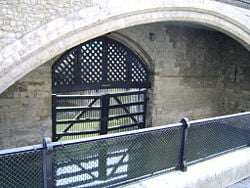
The Tower of London was used as a prison for those of high rank and for religious dissidents. Those of high rank, including prisoners of royal status, were housed in relative comfort. Religious dissidents were however much more severely treated and were often tortured.
The first prisoner was Ranulf Flambard in 1100 who, as Bishop of Durham, was found guilty of extortion. Ironically, he had himself been responsible for various improvements to the design of the Tower after the first architect Gundulf moved back to Rochester. He escaped from the White Tower by climbing down a rope, which had been smuggled into his cell in a wine casket.
Other prisoners include:
- John Baliol, King of Scotland
- David II, King of Scotland
- John II, King of France
- Henry VI of England was imprisoned in the Tower, where he was murdered on May 21, 1471. Popular legend has accused Richard, Duke of Gloucester of his murder. Each year on the anniversary of Henry VI's death, the Provosts of Eton College and King's College, Cambridge, lay roses and lilies on the altar which now stands where he died.
- Margaret of Anjou, wife of the above
- Sir William de la Pole. A distant relative of King Henry VIII, he was incarcerated at the Tower for 37 years (1502–1539) for allegedly plotting against Henry VII, thus becoming the longest serving prisoner there.
- Queen Elizabeth I, imprisoned for two months in 1554 for her alleged involvement in Wyatt's Rebellion.
- John Gerard, S.J. (1564–1637) was an English Jesuit priest, operating undercover during the reign of Queen Elizabeth I, when Catholics were being persecuted. He was captured, then incarcerated and tortured in the Salt Tower before making a daring escape by rope across the moat.
- Sir Walter Raleigh spent 13 years (1603–1616) imprisoned at the Tower, but was able to live in relative comfort in the Bloody Tower with his wife and two children. For some of the time he even grew tobacco on Tower Green, just outside his apartment. Here he wrote The History of the World.
- Niall Garve O'Donnell, Irish nobleman, ironically a one-time ally of the English against his cousin, Red Hugh O'Donnell.
- Guy Fawkes, famous for his part in the Gunpowder Plot, was brought to the Tower to be interrogated by a council of the King's Ministers. However, he was not executed there. When he confessed, he was sentenced to be hanged, drawn, and quartered in the Old Palace Yard at Westminster, however he escaped his fate by jumping off the scaffold at the gallows which in turn broke his neck and killed him.
- Johan Anders Jägerhorn, a Swedish officer from Finland, Lord Edward FitzGerald's friend, participating in the Irish independence movement. He spent two years in the Tower (1799–1801), but was released because of Russian interests.
- Lord George Gordon, instigator of the Gordon Riots in 1780, spent six months in the Tower while awaiting trial on the charge of High Treason.
Executions
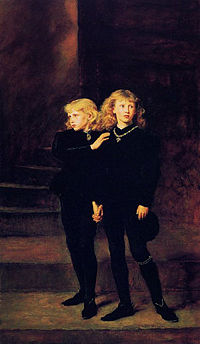
Lower-class criminals were usually executed by hanging at one of the public execution sites outside the Tower. Several high-profile convicts, such as Thomas More, were publicly executed on Tower Hill. Seven nobles (five of them ladies) were beheaded privately on Tower Green, inside the complex, and then buried in the Chapel Royal of St. Peter ad Vincula (Latin for "in chains," making him an appropriate patron saint for prisoners) next to the Green. Some of the nobles who were executed outside the Tower are also buried in that chapel.[4] The names of the seven beheaded on Tower Green for treason are:
- William Hastings, 1st Baron Hastings (1483)
- Anne Boleyn (1536)
- Margaret Pole, Countess of Salisbury (1541)
- Catherine Howard (1542)
- Jane Boleyn, Viscountess Rochford (1542)
- Lady Jane Grey (1554)
- Robert Devereux, 2nd Earl of Essex (1601)
The Queen Anne Boleyn, beheaded in 1536 for treason against King Henry VIII, is said to be seen walking around the tower carrying her head under her arm.
George, Duke of Clarence, the brother of Edward IV of England, was executed for treason in the Tower in February 1478, but not by beheading (and probably not by being drowned in a butt of Malmsey wine, despite what Shakespeare wrote).
However, perhaps the most famous deaths at the Tower were the rumored victims of King Richard III, Edward V of England and Richard of Shrewsbury.
When Edward IV died, he left two young sons behind: the Princes in the Tower. His brother Richard, the Duke of Gloucester, was made regent until the older of his two sons, Edward V, should come of age. According to Thomas More's History of Richard III Richard hired men to kill them, and, one night, the two princes were smothered with their pillows. Many years later bones were found buried at the foot of a stairway in the Tower, which are thought to be those of the Princes. Richard was crowned King Richard III of England.
The last execution at the Tower was that of German spy Josef Jakobs on August 14, 1941 by firing squad formed from the Scots Guards.
Torture
Inside the torture chambers of the tower various implements of torture were used such as the Scavenger's daughter, a kind of compression device, and the Rack, also known as the Duke of Exeter's Daughter.[5]
The Protestant martyr Anne Askew is the only woman on record to have been tortured in the tower, after being taken there in 1546 on a charge of heresy. Sir Anthony Kingston, the Constable of the Tower, was ordered to torture her in an attempt to force her to name other Protestants. Anne was tortured, eventually to her death, on the rack. Kingston was so impressed with the way Anne behaved that he refused to continue punishing her, and Henry VIII's Lord Chancellor had to take over.
Recent History
The military use of the Tower as a fortification, like that of other such castles, became obsolete with the introduction of artillery, and the moat was drained in 1830. However, the Tower did serve as the headquarters of the Board of Ordnance until 1855, and the Tower was still occasionally used as a prison through both World Wars. In 1780, the Tower held its only American prisoner, former President of the Continental Congress, Henry Laurens. In World War I, 11 German spies were shot in the Tower. Irish rebel Roger Casement was imprisoned in the Tower during his trial on treason charges in 1916. The last execution, that of German spy Josef Jakobs, took place during World War II.
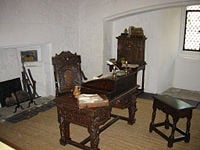
In 1942 Hitler's deputy, Rudolf Hess, was imprisoned in the tower for four days. During this time, RAF Wing Commander George Salaman was placed in the same cell undercover, impersonating a Luftwaffe officer, to spy on Hess. The tower was used as a prison for German prisoners of war throughout the conflict.

Waterloo Barracks, the current location of the Crown Jewels, remained in use as a base for the 1st Battalion Royal Fusiliers (City of London Regiment) into the 1950s. In 1952, the Kray twins were briefly held there for failing to report for national service, making them among the last prisoners of the Tower.
Although it is no longer a royal residence, the Tower officially remains a royal palace, and as such, maintains a permanent Guard, part of the unit forming the Queen's Guard at Buckingham Palace. Two sentries are maintained during the hours that the Tower is open, with one stationed outside the Jewel House and one outside the Queen's House.
Description
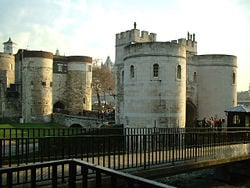
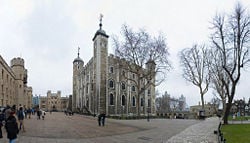

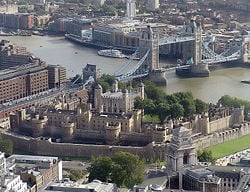
The Tower of London assumed its form as a “concentric” castle, with successive lines of fortification, only after several reigns. Here, the rectangular keep of three stories—the topmost was later divided into two—stands in the center of an inner bailey, the defensive wall surrounding an outer court of a castle, or the courtyard itself. surrounded by a wall with 13 towers (c. 1250), which are in turn, enclosed by an outer bailey and wall with eight towers and an encircling moat (c. 1280). The oldest visible structure is the White Tower; other elements added over the centuries are evident, right up to modern additions, most of which cater for the tourist or security needs. The massive White Tower is representative of Norman military architecture, which is found throughout the kingdom.
The White Tower is the central tower at the Tower of London. It is a massive construction, 90 feet high and 118 feet by 107 feet across, the walls varying from almost 11 feet thick in the upper parts to15 feet at the base. Above the battlements rise four turrets; three of them are square, but the one on the northeast is circular. This turret once contained the first royal observatory.
The Tower includes the following 21 towers, listed in alphabetic order:
- Beauchamp Tower (pronounced “Beecham”)
- Bell Tower
- Bloody Tower (or the Garden Tower), so named after a legend that the Princes in the Tower were murdered here. Allegedly also haunted by the young princes.
- Bowyer Tower
- Brick Tower
- Broad Arrow Tower
- Byward Tower
- Constable Tower
- Cradle Tower
- Develin Tower
- Deveraux Tower
- Flint Tower
- Lanthorn Tower
- Martin Tower
- Middle Tower
- St. Thomas's Tower
- Salt Tower
- Wakefield Tower
- Wardrobe Tower
- Well Tower
- White Tower
Crown Jewels
The Crown Jewels have been kept at the Tower of London since 1303, after they were stolen from Westminster Abbey. It is thought that most, if not all, were recovered shortly afterwards. After the coronation of Charles II, they were locked away and shown for a viewing fee paid to a custodian. However, this arrangement ended when Colonel Thomas Blood stole the Crown Jewels after having bound and gagged the custodian. Thereafter, the Crown Jewels were kept in a part of the Tower known as Jewel House, where armed guards defended them.
They were temporarily taken out of the Tower during World War II, and were reportedly secretly kept in the basement vaults of the Sun Life Insurance company in Montreal, Canada, along with the gold bullion of the Bank of England. However, it has also been said that they were kept in the Round Tower of Windsor Castle, or the Fort Knox Bullion Depository, in the United States. The Windsor Castle option is the most likely, as the Crown Jewels are not supposed to leave the country. Many of the Crown Jewels are available for public inspection at the Jewel House today. They are one of the Tower's most popular attractions.
Notes
- ↑ BBC News. Big Cats Prowled London's Tower. Retrieved July 13, 2007.
- ↑ Camelot International. Tower of London. Retrieved July 13, 2007.
- ↑ Guardian Unlimited. Tower's Raven Mythology May be a Victorian Flight of Fantasy Retrieved July 13, 2007.
- ↑ Camelot International. Chapel of St. Peter ad Vincula. Retrieved July 13, 2007.
- ↑ The Tower of London. Ghosts and Hauntings in Britain. Retrieved July 13, 2007.
References
ISBN links support NWE through referral fees
- Abbott, G. Ghosts of the Tower of London. Hendon Publsihing Co. Ltd. 1989. ISBN 978-0860671237
- Diehl, Daniel. Tales from the Tower of London Sutton Publishing. 2006. ISBN 978-0750934978
- Impey, Edward, Hammond, Peter, and Thurley, Simon. The Official Tower of London Guidebook. Historic Royal Palaces. 2000.
- Impey, Edward, and Parnell, Geoffrey. The Tower of London: The Official Illustrated History. Merrell. 2000. ISBN 978-1858941066
- Parnell, Geoffrey. The Tower of London: A 2000 Year History. Osprey Publishing. 2000. ISBN 978-1841761701
External Links
All links retrieved March 14, 2020.
- Camelot International. The Tower of London.
- Dick and Jane’s Travels. The Tower of London.
- English Monarchs. The Tower of London.
| World Heritage Sites in the United Kingdom | |
|---|---|

Blenheim Palace · Canterbury Cathedral – St. Augustine's Abbey – St. Martin's Church · Bath · Cornwall and West Devon Mining Landscape · Derwent Valley Mills · Durham Castle and Cathedral · Ironbridge Gorge · Jurassic Coast · Frontiers of the Roman Empire (Hadrian's Wall) · Kew Gardens · Liverpool · Maritime Greenwich · Westminster Palace – Westminster Abbey – St. Margaret's Church · Saltaire · Stonehenge and Avebury · Studley Royal Park and Fountains Abbey · Tower of London |
|
|
Edinburgh Old Town and New Town · Heart of Neolithic Orkney (Maeshowe • Ring of Brodgar • Skara Brae • Standing Stones of Stenness) · New Lanark · St. Kilda |
|
|
Castles and Town Walls of King Edward I in Gwynedd (Beaumaris Castle • Caernarfon Castle • Conwy Castle • Harlech Castle) · Blaenavon |
|
| Giant's Causeway | |
| Overseas territories |
Henderson Island · Gough Island and Inaccessible Island · St. George's Town |
Credits
New World Encyclopedia writers and editors rewrote and completed the Wikipedia article in accordance with New World Encyclopedia standards. This article abides by terms of the Creative Commons CC-by-sa 3.0 License (CC-by-sa), which may be used and disseminated with proper attribution. Credit is due under the terms of this license that can reference both the New World Encyclopedia contributors and the selfless volunteer contributors of the Wikimedia Foundation. To cite this article click here for a list of acceptable citing formats.The history of earlier contributions by wikipedians is accessible to researchers here:
- Tower of London history
The history of this article since it was imported to New World Encyclopedia:
- History of "Tower of London"
Note: Some restrictions may apply to use of individual images which are separately licensed.
↧ Download as ZWI file | Last modified: 02/04/2023 02:48:39 | 23 views
☰ Source: https://www.newworldencyclopedia.org/entry/Tower_of_London | License: CC BY-SA 3.0
 ZWI signed:
ZWI signed: KSF
KSF